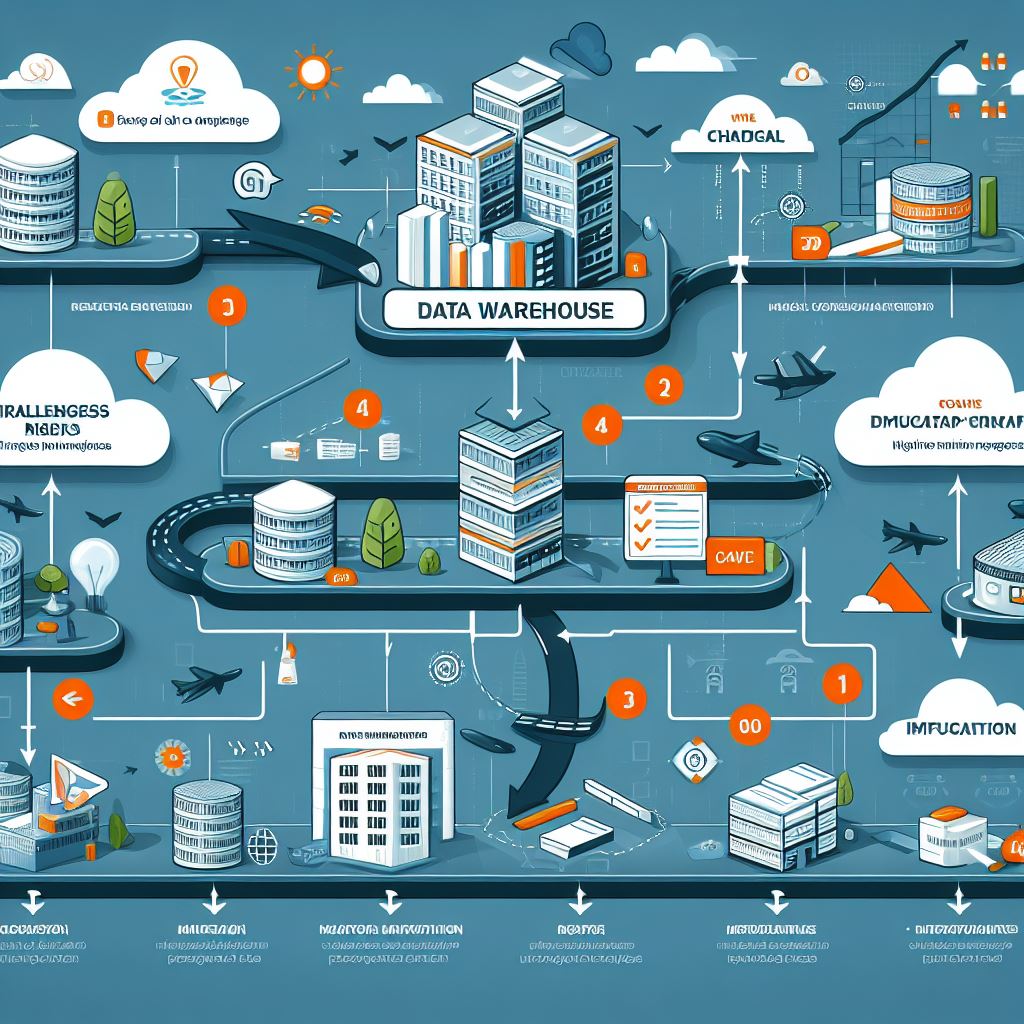When it comes to modernizing data infrastructure, many organizations are opting for data warehouse migration to cloud environments. This strategic move involves transferring the existing data warehouse, including data models, pipelines, and analytics, to a cloud platform. However, it’s imperative to understand the nuances and challenges associated with this migration process to ensure a successful transition. In this article, we’ll delve into the key aspects of data warehouse migration to the cloud, the challenges it presents, and best practices for a seamless transition.
Contents
What is Data Warehouse Migration?
Data warehouse migration refers to the process of moving an organization’s data warehouse from an on-premises infrastructure to a cloud-based data warehouse. The data migration aspect involves transferring the current data, data models, and analytics processes to the new cloud environment. This shift is driven by the need for scalability, flexibility, and improved data processing capabilities offered by cloud platforms.
Understanding the Data Warehouse Migration Process
The data warehouse migration process involves several critical steps, including assessing the existing data warehouse, identifying the type of data to be migrated, devising a migration strategy, and implementing the migration project. It also entails ensuring data integrity and seamless data transfer to the cloud environment while maintaining the functionality and performance of the data warehouse.

Key Considerations for Migrating Data Warehouses to the Cloud
During data warehouse migration to the cloud, important considerations include evaluating the data volume, assessing the legacy data challenges, and choosing the right migration tools to streamline the process. Additionally, understanding the impact on enterprise data systems and integrating new data sources are vital considerations for a successful migration.
Choosing the Right Data Warehouse Migration Strategy
Selecting the appropriate migration strategy, whether it’s a lift-and-shift approach or a phased migration, is crucial. Each strategy has its own advantages and challenges, so organizations need to evaluate their specific requirements and goals before deciding on the most suitable approach.
Challenges in Data Warehouse Migration
While data warehouse migration offers numerous benefits, it also presents several challenges that need to be addressed to ensure a smooth transition. These challenges include managing legacy data, mitigating risks associated with cloud data migration, and maintaining data integrity throughout the migration process.
Addressing Legacy Data Challenges in Migration
Migrating legacy data from an on-premises data warehouse to a cloud environment requires thorough assessment and validation to ensure compatibility and integrity. Incompatibility issues and data transformation complexities should be carefully addressed during the migration process.
Mitigating Risks in Cloud Data Warehouse Migration
Security, data privacy, and compliance with regulations are critical aspects that need to be carefully managed during cloud data warehouse migration. Data teams must implement robust security measures and establish clear protocols to mitigate potential risks associated with the migration process.

Ensuring Data Integrity During Data Warehouse Migration
The integrity of the data being migrated is paramount. Any discrepancies in data processing and transfer can significantly impact the functionality and reliability of the data warehouse in the cloud. Data validation processes and efficient data transfer mechanisms are essential for maintaining data integrity.
Best Practices for Successful Data Warehouse Migration
To ensure a successful data warehouse migration to the cloud, organizations should adopt best practices that optimize data models, implement efficient data pipelines, and strategize for migrating on-premises data to cloud environments.
Optimizing Data Models for Cloud Data Warehousing
Adapting data models to suit the requirements of a cloud data warehouse is crucial. Optimizing the data structure and storage mechanisms can enhance performance and scalability in a cloud environment.
Implementing Efficient Data Pipelines for Migration
Efficient data pipelines facilitate seamless data transfer and processing during migration. Streamlining data pipelines and integrating data processing tools can significantly reduce the complexities associated with large-scale data migration projects.
Strategies for Migrating On-Premises Data to Cloud Environments
Organizations need to devise comprehensive strategies for migrating on-premises data to cloud environments, considering factors such as data volume, data types, and the compatibility of the existing infrastructure with the cloud platform. A well-planned migration approach ensures minimal disruption and maximum efficiency during the transition.
Choosing the Right Migration Tools
Selecting the appropriate migration tools and solutions is a critical aspect of data warehouse migration to the cloud. These tools are essential for streamlining the migration process, validating data integrity, and ensuring a seamless transition.
Evaluating Data Warehouse Migration Tools and Solutions
Organizations must evaluate the available data warehouse migration tools and solutions to identify the most suitable options based on their specific requirements. Assessing features, compatibility, and support options offered by different tools is essential for making informed decisions.
Considerations for Selecting Migration Tools Based on Data Types
Different types of data require specific migration tools and approaches. Whether it’s structured data, unstructured data, or semi-structured data, selecting migration tools based on the nature of the data is crucial for ensuring efficient and accurate data transfer.

Best Practices for Utilizing Migration Tools in Data Warehouse Migration
Adopting best practices for utilizing migration tools involves implementing data validation processes, conducting thorough testing, and establishing seamless integration with the cloud environment. Organizations should also prioritize user training and support to maximize the benefits of migration tools.
Key Considerations for Enterprise Data Warehouse Migration
Enterprise data warehouse migration involves a holistic approach that addresses the impact on existing data systems, integrates new data sources, and ensures smooth data transfer to the cloud environment.
Assessing the Impact of Migration on Enterprise Data Systems
Understanding the impact of migration on enterprise data systems and processing mechanisms is crucial. It involves assessing the compatibility of the existing data infrastructure with the cloud platform and strategizing for a seamless transition without disruptions.
Adopting a Holistic Approach to Enterprise Data Warehouse Migration
Employing a holistic approach encompasses addressing not only the technical aspects of migration but also the organizational impact and change management requirements. It involves collaboration with various stakeholders to ensure a smooth and coordinated migration process.
Integrating New Data Sources in Cloud Data Warehouse Environments
The integration of new data sources in cloud data warehouse environments requires careful planning and execution. Organizations need to consider the scalability and compatibility of the cloud environment for accommodating new data sources while maintaining optimal performance and data integrity.
Frequently Asked Questions [FAQs]
Q: Why should we consider migrating our data warehouse to the cloud?
Migrating to the cloud offers scalability, cost-efficiency, and accessibility, allowing for better performance, flexibility, and the adoption of advanced analytics.
Q: What are the key challenges associated with data warehouse migration to the cloud?
Challenges may include data security concerns, ensuring data consistency during migration, managing the transition period, and aligning existing processes with cloud-based technologies.
Q: How can we choose the right cloud platform for our data warehouse migration?
Evaluate factors such as performance, scalability, cost structures, security features, and integration capabilities to determine the cloud platform that aligns best with your organization’s needs and goals.
Conclusion
The migration of a data warehouse to the cloud may seem like a daunting task, but with careful planning and understanding of the process, it can be a seamless transition. Cloud migration offers numerous advantages, including cost savings, increased efficiency, and improved scalability. It’s a strategic move that can transform your business operations and drive growth in today’s fast-paced digital landscape. It’s not just about moving data from point A to point B; it’s about leveraging the power of cloud technology to unlock new opportunities and competitive advantages. So, isn’t it time you considered understanding the process of data warehouse migration to the cloud?





